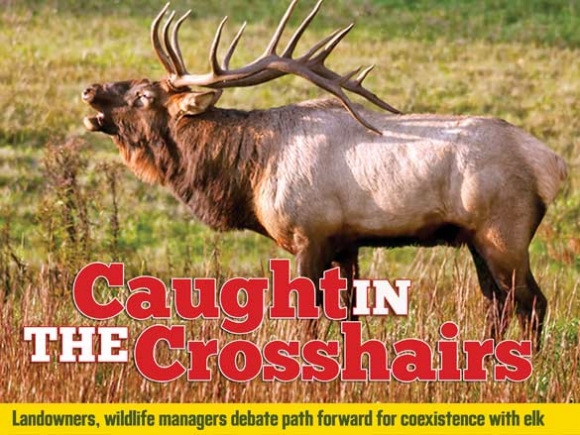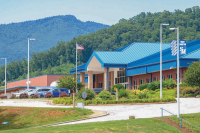Growing elk population triggers landowner conflicts, land conservation efforts

Elk may be the most polarizing animal in Western North Carolina right now, but William Carter has kept a closer eye on the issue than most. Carter makes his living off a small mountain farm in the Jonathan Creek area, sharing a property line with the Ross dairy farm — that family’s elk-related struggles have earned them plenty of unwanted time in the local spotlight.
SEE ALSO: Two-mile fence keeps elk off dairy farm following winter shooting of seven animals
As the elk population has grown, Carter’s found himself wondering what the future holds for his acres of beans, pumpkins and cattle pasture.
“I haven’t had any damage yet, but it’s coming. It’s increasing,” Carter said, standing in the shade of a large cherry tree as he packed baskets full of this year’s harvest of greasy beans. “I’m seeing more elk, more elk. As of yet I’ve kept them harassed off, and that’s a job in itself. It takes time and effort for me to do.”
In the never-ending business of running a farm, each second of daylight is a precious resource. So, while hours spent mending the torn-down fences and riding a four-wheeler around to scare the elk away haven’t been a financial burden, they’re tasks that use up working hours he can’t spare.
Related Items
Not in the budget
But all that’s small potatoes compared to what would happen if the herd of elk over at the Ross farm broke into his bean patch. Carter doesn’t expect it would take that long for a passel of 500- to 700-pound animals to finish off his 2 acres of beans, filling their bellies with the lion’s share of his yearly revenue.
“It wouldn’t cut into me,” he said. “It would do me in.”
Carter was in his 20s when the elk were first released in Cataloochee. If somebody had asked his opinion then, he said, it would probably be different than it is now. Elk are amazing animals, and he would have appreciated all that their return to the Smokies represented. But nobody asked his opinion before the elk were released, a fact that still negatively colors his view on the animals today. And these days any favorable feelings he has about them are balanced by years of experience living and farming among them — and it’s not all rainbows and unicorns.
“They’re not figured into my budget,” he said. “It’s everything I can do to keep my cows here and have enough grass just for them.”
Carter compares the impact of the ranging elk herd to that of turning his 30 cows loose on Jonathan Creek to feed wherever they please. The landscape of farm-studded Appalachia just isn’t suitable for large, free-ranging animals like elk, he believes.
The Ross family has been back and forth with wildlife managers for years about their elk-related issues, reporting crop damage and fence damage and harried dairy cows. All that came to a head this winter, when seven elk were shot on the property (see story on page 7). Following the incident, the N.C. Wildlife Resources Commission funded a 2-mile-long fence around the farm to prevent similar situations in the future. It seems to be working well for the Ross farm, but Carter says he’s seen more elk on his land since — foiled from entering the Ross fields, he said, they’ve been skirting the property line to end up in his neck of the woods.
So what happens when the day comes — and Carter is sure it will — that elk damage threatens his livelihood? He’s got a daughter in college and another coming up behind her — elk in the bean patch could have quite tangible implications. But killing an elk, he said, is the last thing he wants to do.
“I have the right (to shoot) just as soon as it’s in my field and it’s doing damage,” he said. “I have that right. Is that what I want to do? No.”
Down the road from Carter, Brooke Parrott is wrestling with similar concerns. She and her husband don’t grow commercial products on their 20 acres, but they do keep livestock, tend a garden and try to create a peaceful, healthy environment for their children to grow.
Elk have complicated that picture. Several years ago, the elderly family dog was stomped to death right in front of her. Another dog got its eyeball and teeth kicked out.
“I chose to live on a large tract of land for a way of life, to have farm animals to enjoy, and yet I’m having to keep my dogs chained up, keep close eyes on my kids, because they (elk) are very large animals, and they’re dangerous,” Parrott said.
But what can she do about it? The Wildlife Commission may have erected a fence around the Ross property, but would that even make sense for her family’s hobby farm? It would be expensive, and it would alter the feel of the land.
“It would look like Donald Trump’s wall,” she said.
Both Parrott and Carter emphasized that they’re not anti-elk, per se. They both grew up in the area and both have a love and respect for wild animals. But elk are different, they said — because of their size, because of their lack of fear of humans and because they’ve only so recently become part of the picture. Before elk were reintroduced in the Great Smoky Mountains National Park in 2001, they’d been absent from the region for 200 years.
“I’m not saying anybody’s right or wrong,” Parrott said. “I’m just saying you have to understand what people have dealt with to understand why they have such strong opinions and things have escalated the way they have.”
Applauding the elk
Kim Delozier, the Smokies biologist who spearheaded the reintroduction effort and now works for the Rocky Mountain Elk Foundation, has heard stories like Parrott’s and Carter’s many times before.
“You really enjoy helping those people that don’t want to kill them. They just don’t want their property impacted in a negative way,” Delozier said. “That’s the people that’s the easiest to help.”
Delozier worked with landowners back when he was with the park, and now that he’s with the Elk Foundation he partners with the state on projects to benefit the elk population and reduce conflicts with humans. He’s no stranger to the issues that can arise when the enormous ungulates wander onto private land, but Delozier is a believer that those issues can — and should — be worked out.
“For a long time, we lost a lot of species here, and it’s really because of bad decisions that people made,” he said. “We killed too much and we destroyed too much habitat. Because of that we lost some species, and elk was one of those. I think it’s our responsibility to see which ones we can bring back and restore them.”
Elk aren’t the only species the park’s brought back over the years. River otters, peregrine falcons and the ill-fated red wolves all had their own reintroduction programs. Co-existence with elk has its challenges, Delozier said, but they’re native here. They belong here. They occupy a niche in the environment that would go empty without them.
And people love to see them. Elk viewing is a big draw in Haywood County, with visitation to the Cataloochee area of the park, where they were reintroduced, skyrocketing from 65,400 in 2000 to 214,000 in 2003, following the 2001 reintroduction. Visitation has since slid back down to around 90,000, still substantially higher than before the elk came.
Tourism, in turn, puts money in the pockets of county residents, both directly — through revenues to local stores and hotels — and indirectly, through the $260 that visitor spending saved each Haywood County resident in taxes this year. If the population grows to a point that it’s huntable, tourist dollars could be expected to grow even more.
“Elk really are valuable for the local economy, for tourism, for wildlife viewing and hopefully in the future for a huntable population,” Delozier said.
Eye of the beholder
From where Carter sits, elk are a net negative, economically speaking.
“It’s great if it’s not affecting your life, but they need to figure some way to compensate the people that are on a daily basis having to deal with the elk,” he said.
If he were getting some financial compensation for the headache of dealing with elk or — if it should someday come to that — damage they cause his crops, he’d be much more OK with their presence. After all, the government let them loose, so shouldn’t the government be responsible for the headaches they cause producers?
“I understand that completely, that feeling,” said Justin McVey, district biologist for the Wildlife Commission. “Some states are set up that they do pay damages. North Carolina is one that had not, and I don’t foresee that changing. That’s a big funding thing.”
Sometimes, though, damages are in the eye of the beholder. What’s unacceptable to one person may be allowable to another. And sometimes the pent-up frustration of years of elk encounters builds to a point that each subsequent incident, however minor, elicits a reaction disproportionate to the actual damage. Previous encounters with elk eating crops from a field or tearing down fences come to bear on the present — when, perhaps, all the animal is actually doing is standing in the pasture — and anger rises quickly.
McVey recalls one time when, after a landowner complained that elk were eating all his hay, he set up an exclusion cage in the field — a section of fence to keep elk out for the purpose of evaluating the difference between vegetation inside the cage and vegetation outside the cage.
“There was no difference,” McVey said.
“There’s no doubt that they do damage, but I don’t know that the severity is there,” he continued. “I think that the fact that it’s elk doing it just exacerbates the problems.”
There’s been some research done on the topic, with a 1995 paper from Dennis Austin and Philip Urness of Utah State University looking at the effect that grazing from “wild ungulates” — the category includes deer, elk and moose, among others — have on the grain yield of winter wheat. The study concludes that “despite high utilization percentages” foraging didn’t significantly decrease overall grain yields.
“It’s almost like the wheat responds,” McVey said. “It’s like being mowed — it grows better.”
So, perhaps even a mowed-down section of winter wheat won’t actually translate to damage if you wait till spring to measure. The question is, if your livelihood depends on how well your cattle are fed, do you just trust that it will be OK and keep breathing easy as elk graze the fields?
“I’m not a beef farmer — I’m a grass farmer,” Carter said.
Success raising beef depends on success growing grass.
Defining damage
Which leads to the question — what is damage? State law says that if an animal is in the act of damaging property, it’s the property owner’s right to shoot it. But the law doesn’t define damage.
“Eating a blade of grass in your yard might not be damage, but eating grass on a man that’s growing grass for a living is damage,” Carter said.
But even that perspective isn’t universal, Delozier said. He remembers working with one landowner who would have taken the definition even further.
“He said, ‘Look, the elk have been walking around the edge of my yard eating my apples. They’ve even been stepping on my weeds,’” Delozier recalled. “His interpretation of ‘damage’ was stepping on his weeds.”
“It’s gray,” McVey said. “It’s a really bad rule.”
At one point long ago, McVey said, the law defined “damage” as anything valued at more than $50. That was more concrete than the current statute, but still gray. For instance, what if an elk knocks down a length of fence that doesn’t cost money to repair but requires hours to put back up? How do you calculate the cost of the labor?
“We’re always looking at all our wildlife rules and trying to make them more clear and more impactful,” McVey said. “I believe there are some discussions going on to try to improve those rules.”
But that’s easier said than done, said Brad Howard, private lands program coordinator for the Wildlife Commission.
“Situations with wild animals are unpredictable and varied,” he said. “You can never write something on paper that can accommodate and account for every situation that wild animals might throw at you.”
And elk are not the only animal to which the depredation law applies. If you define “depredation,” you’re defining it for all North Carolina’s wildlife species.
“I’m hesitant to go too far down that road because there are so many scenarios and situations that play out across the state of North Carolina,” Howard said. “This doesn’t just apply to a local issue.”
But something more concrete than the existing statute would make things a lot easier for Capt. Mitchell Kirkland and the wildlife enforcement officers who work under him.
“It can make it hard to enforce,” Kirkland said. “That’s because it comes down to deciding what is depredation, what isn’t depredation. What has that monetary value that actually spells out ‘yes, it’s OK to take the life of that animal?’”
There have been scenarios in North Carolina in which someone claimed depredation after shooting an animal, Howard said, only for the investigation to reveal that no damage had actually occurred. People have been criminally charged for such offenses, he said. But in cases where there is real damage, there’s no clear-cut legal threshold to say what’s worth an elk’s life and what is not.
From Kirkland’s standpoint, the process works much better when landowners approach his staff before things get to the point of loading a gun. Then they can work on some non-lethal measures to solve the problem, like fencing or loud noises. The landowner can document the situation with photographs, and if it gets to the point that gunshots are necessary, a timeline has been established to aid officers in their investigation.
“If a person takes it (the elk) and they haven’t jumped through the hoops to get there, it doesn’t look good on their end because they haven’t made any effort to do anything other than shoot it,” Kirkland said.
And logistically, if an elk is shot without a depredation permit, the landowner is left with the unpleasant task of burying 700 pounds of dead animal. If they’ve gone through the process to obtain a depredation permit, the meat can actually be put to use.
“We don’t want to see any animal be taken unnecessarily, so learning how to balance the needs of the animals with the lives of the people is tough,” Kirkland said.
For his part, Carter emphasizes that he has no wish to kill an elk. But he’s afraid that he may someday be forced to.
“Even when the elk stomped my dog right in front of my face, I didn’t want to kill them,” concurred Parrott.
Guiding the future
Parrott’s home is located at a spot that biologists have praised as textbook elk habitat, offering grassy fields, scrubby young forest and a water source — an elk smorgasbord. That kind of open habitat is a rare commodity in the Smokies region, at least when it comes to public land — acreage in Western North Carolina tends heavily toward mature forest.
So, for Delozier and his partners in the Wildlife Commission, the goal is to increase that open acreage in places besides the Parrotts’ backyard or the Ross’ pastures.
“Elk utilize the forested areas quite a bit so they can survive and do relatively well, but where there are openings, kind of a mosaic habitat, they will thrive,” he said.
The Conservation Fund has been a stalwart ally toward that goal. To date, the organization has purchased 959 acres of land near Maggie Valley — enveloping Sheepback Mountain and abutting the Great Smoky Mountains National Park — for the Wildlife Commission. The effort’s been helped along by $1.5 million from the N.C. Clean Water Management Trust Fund, as well as contributions from the elk foundation and other public and private funding sources. By the end of the year, The Conservation Fund expects to convey an additional 955 acres and is talking to more landowners about purchasing another 600 acres for eventual conveyance to the Wildlife Commission.
“Where suitable, we’re going to be creating wildlife habitat in various stages, even if it’s just thinning and burning,” McVey said. Eventually, the area will include the hodgepodge of meadows, scrub and mature forest that elk thrive on.
Other elk habitat projects are also underway. McVey started working on an endeavor in the 12 Mile area — east of the Great Smoky Mountains National Park and south of the Tennessee border — about four years ago. Some overgrown fields have been reclaimed as meadow, and there’s one area of about 250 acres that he’s hoping to thin and burn to create some savannah-like young forest habitat. In addition, the U.S. Forest Service is currently in the planning phase of a logging project in that neck of the woods, and creation of new elk habitat will be one of the project’s foremost goals. And, over the last several years the Elk Foundation has been funding prescribed burning projects to open habitat within the park itself.
The hope is that a nucleus of safe, desirable habitat on public land will pull elk away from crops and fences and conflicts with cars and guns, resulting in a more stable elk population and a reduction in damages on private farms.
“I think having that land and having the public’s acceptance of elk are going to be key to the successful conservation of elk in North Carolina,” McVey said.
The fact that elk are now part of the equation will likely mean that openings, once created, will stay open with substantially less human intervention.
“Elk were part of the landscape before, and elk was a species that helped maintain the openings,” Delozier said. “When elk were gone, you didn’t really have anything to keep those areas open.”
Parrott hopes that forest management efforts will improve the situation, but she also believes a positive future for the elk herd will require another initiative — a hunting season.
“They’re smart. They know there’s nothing out there that’s going to hurt them,” she said. “I think opening a hunting season would at least change the behavior of the animals so they’re more like a wild animal.”
Right now, Parrott said, they’re barely wild. It’s not uncommon for her to come home and find one standing in her driveway, utterly unfazed when she lays on the horn.
“They’re not wild,” Carter agreed. “They’re far from being wild. They’ve been humanized right here. You can pull your vehicle out and they’ll stick their head in your window.”
Delozier doesn’t disagree with any of that. In fact, he said, the Rocky Mountain Elk Foundation would love to see an elk season happen someday — down the road, when the population has grown enough to sustain it. Earlier this year, the Wildlife Commission amended its rules so that a hunting season could be implemented once biologists give the go-ahead.
“It would definitely increase fear in any animal,” he said. “It happens with bears, too, in areas where they’re hunted versus areas where they’re not hunted. A hunted population of anything is much less visible and wilder than a population that is not.”
But for now, the status quo is what folks like Parrott and Carter will have to deal with. Habitat projects take time, and it will likely be a while before the elk population grows to a point that a hunting season — even a strictly limited hunting season — makes sense.
Animal of the people
Even with all the hassle, Parrott said, having the elk around isn’t all bad. The wonder of spring calving season, for instance, isn’t lost on her or her family.
“It’s nice that you can sit on the porch and see they still have spots and their legs are shaky,” she said. “There are good things that we experience too, but as they get older we deal with the destruction.”
Spread your circle wider, to the community and region and nation as a whole, Delozier said, and it’s even easier to identify the positive impacts the elk population yields. At the Haywood County Tourism Development Authority, elk account for the biggest share of calls from visitors and travel writers — last year, the TDA even put out a travel guide specifically designed to tell visitors where to go to see an elk. Those people come with their families and their dollars and in turn bolster all sorts of local businesses.
Transcending dollars and cents, the elk reintroduction is downright emotional to many people.
During last month’s dedication of the new Waterrock Knob Park on the Blue Ridge Parkway, Conservation Fund Chairman Mike Leonard teared up as he addressed the crowd, describing how elk have been spotted roaming the newly conserved, one-of-a-kind property.
“I don’t want to choke up, but elk have returned up here for the first time in more than a century,” he said. “That is an incredible restoration story. That is happening.”
Statements like that are good news to Delozier, who is well aware that the elk population will survive only as long as there are people who want it to. The species has disappeared once, and it could disappear again.
“The people are really the ones that are going to decide what we have and what we don’t have,” he said. “Overall, I’m very encouraged that elk have a lot of support — not just in the park but really across the state of North Carolina.”
Maintaining that support, he said, will require asking hard questions and dealing head-on with the very real conflicts that the reintroduced population brings.
“Ignoring the problems, obviously you’re not going to win,” Delozier said. “I think having open lines of communication, better relationships will be better for the landowners, for all people involved, and definitely for the elk.”









